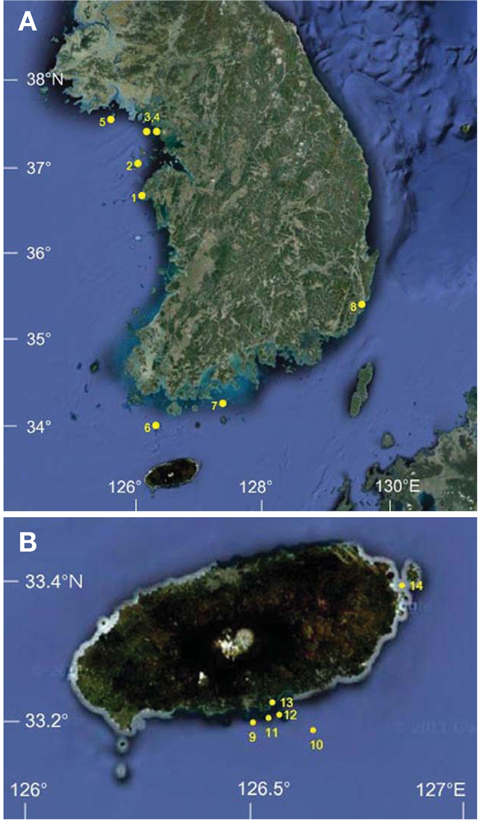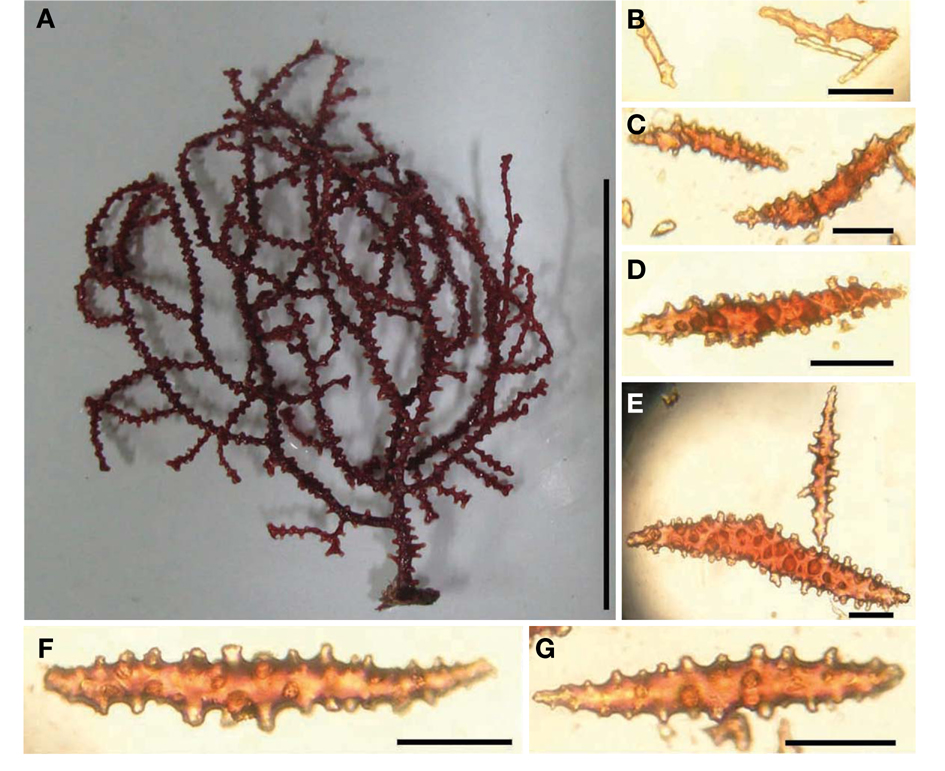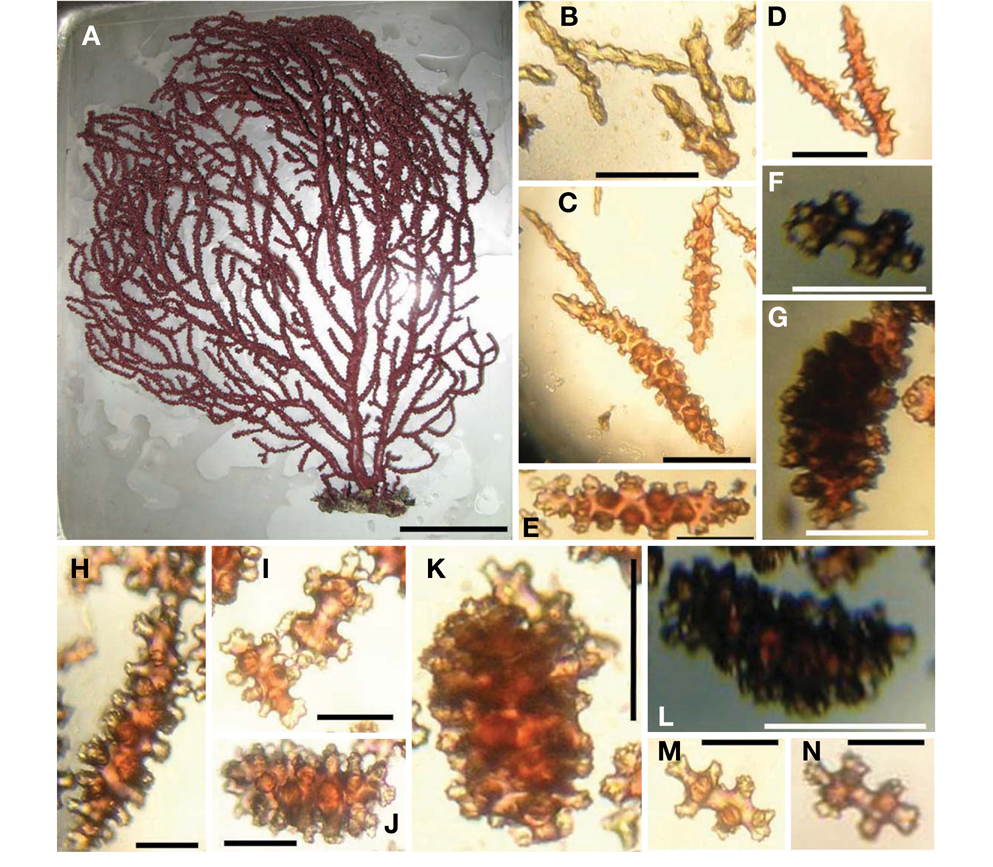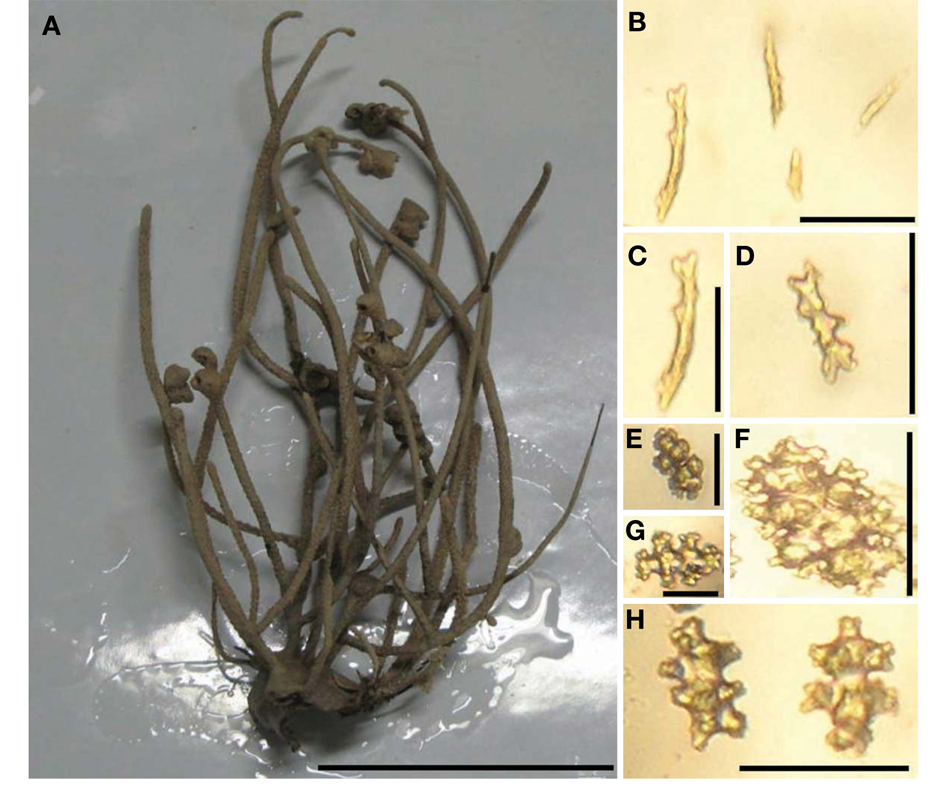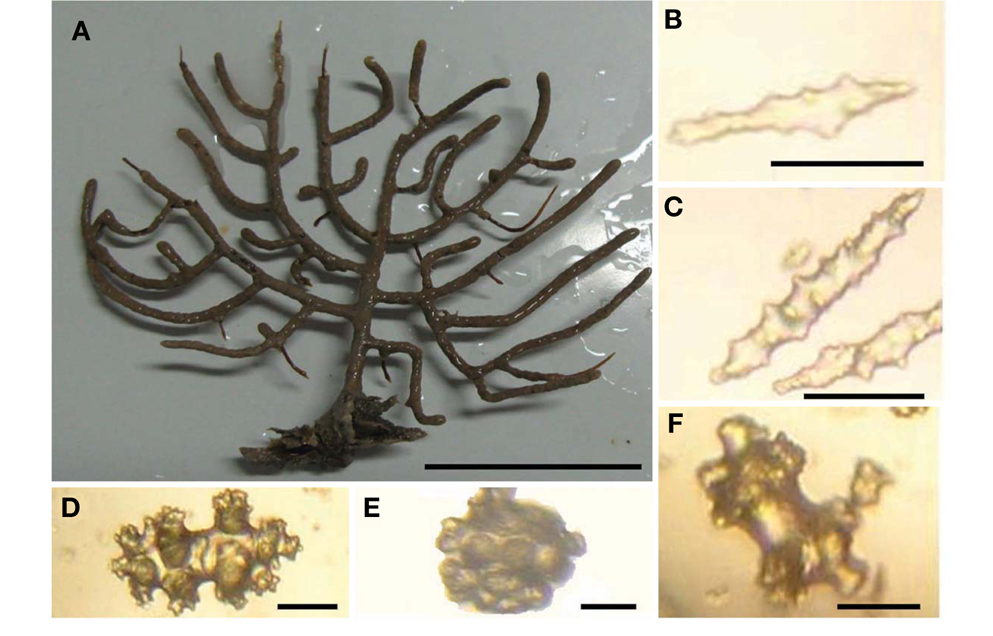



Suborder Holaxonia is distinguished by axis with a hollow and cross-chambered central core. It contains primarily gorgonin, often with small amounts of non-scleritic calcite. In Korean waters, holaxonians have been consisted of 11 genera and 28 species within families Acanthogorgiidae and Plexauridae (Song, 2004). In particular, both families are distinguished by the types of polyps in their contraction. Unlike Acanthogorgiidae which has conspicuous and non-retractile polyps, Plexauridae has completely retractile polyps. As a result of this taxonomic study, four holaxonian species are added to the Korea holaxonian fauna.
Specimens were collected from the intertidal zone of the western coasts and the sublittoral zone of the western and southern coasts, and Jeju-do Islands of Korea by SCUBA diving and fishing nets from 1969 to 2010 (Fig. 1). The morphological characters of polyps, coenenchyme, and axis of specimens were observed under the stereomicroscope (StemiSV-6; Carl Zeiss, Jena, Germany) attached with a digital camera (5060-WZ; Olympus, Tokyo, Japan), and the stereomicroscope (S8APO; Leica, Wetzlar, Germany) with camera (DFC 290; Leica). Images of spicules’ types were taken by the light microscope (Olympus BH2; Olympus) mounted with a digital camera (5060-WZ; Olympus), and light microscope (Eclipse 80i; Nikon Co., Tokyo, Japan) with camera (DS-5Mc; Nikon Co.). The name of each spicule types were followed by Bayer et al. (1983). The coloration of colony and spicule were recorded with a color code based on the color chart (Professional Textbook for Comprehension on Color Image, Hue and Tone 120, Korea).
Phylum Cnidaria Hatschek, 1888 Class Anthozoa Ehrenberg, 1834 Subclass Octocorallia Haeckel, 1866 Order Alcyonacea Lamouroux, 1816 Suborder Holaxonia Studer, 1887 Family Acanthogorgiidae Gray, 1859
Diagnosis. Holaxonia with non-retractile polyps and axis containing no calcite. In polyps, spicules extending up to tentacles.
1*Genus Anthogorgia Verrill, 1868
Diagnosis. Calyxes prominent, tall, cylindrical, and clavate. Spicules of calyx indistinctly
2*Anthogorgia japonica Studer, 1889 (Table 1, Fig. 2)
[Table 1.] Measurements, shapes, and colors of spicules of Anthogorgia japonica

Measurements, shapes, and colors of spicules of Anthogorgia japonica
Material examined. Korea: 1 ind., Jeju-do: Seogwipo-si, Munseom, 28 Dec 1987, Han HS; 1 ind., Seogwipo-si, Munseom, 25 May 2006, INTHESEA KOREA; 1 ind., Seogwiposi, Seopseom, 27 Jul 2006, Hwang SJ, Choi EJ, Choi IY; 1 ind., Seogwipo-si, Jigwido, 14 Apr 2007, Hwang SJ, Cho IY; 1 ind., Seogwipo-si, Jigwido, 15 Apr 2007, Hwang SJ, Cho IY; 1 ind., Seogwipo-si, Munseom, 30 May 2008, Hwang SJ, Cho IY; 1 ind., Seogwipo-si, Beomseom, 6 Jan 2009, INTHESEA KOREA; 5 inds., Seogwipo-si, Beomseom, 7 Jan 2009, INTHESEA KOREA; 4 inds., Seogwipo-si, Munseom, 4 Nov 2009, INTHESEA KOREA, 18-25 m deep by SCUBA diving.
Description. Colonies 78-165 mm in height, 55-155 mm in width, planar growth form, anastomosis. Main branches 10-140 mm in length, 2 mm in width arise from stem at angles of 60-70°, 5-15 mm interval. Second branches 5-40 mm in length, 1 mm in width arise from main branches at angles of 20-90° , 5-7 mm interval. Calyxes, 0.6-0.8 mm in height, 0.2-0.5 mm in width scattered with 1.0-1.4 mm interval. Calyxes arise at a right angle, arrange in irregular spirals. In thickness, coenenchyme 0.05-0.1 mm at lower part, 0.1-0.2 mm at upper part. Axis 1.0-1.1 mm at lower part, 0.1-0.2 mm at upper part, oval shape. In living state, colony deep red (No. 91) with pale yellow (No. 32) polyp. Axis dark yellow (No. 103) at lower part, very pale yellow (No. 43) at upper part.
Remarks. In comparison with Studer’s description (Studer, 1889), our specimens have narrow interval and low height in calyxes. And also, they differ from small spicules, 0.09× 0.01-0.16×0.03 mm in polyps and 0.16×0.04-0.43×0.07 mm in coenenchyme.
Distribution. Pacific Ocean: Korea (Jeju-do Island), Japan (Sagami Bay).
Family Plexauridae Gray, 1850
Diagnosis. Holaxonia with retractile polyp and axis with hollow and cross-chambered central core surrounded by gorgonin with locules that contain embedded non-scleritic calcite.
3*Genus Astrogorgia Verrill, 1868
Diagnosis. Colonies growing in one plane with irregular lateral branching. Polyps retracted into calyxes. Calyxes often in two rows but can occur all around of stem and branch. All surface spicules spindle.
1*Astrogorgia rubra Thomson and Henderson, 1906 (Table 2, Fig. 3)
[Table 2.] Measurements, shapes, and colors of spicules of Astrogorgia rubra
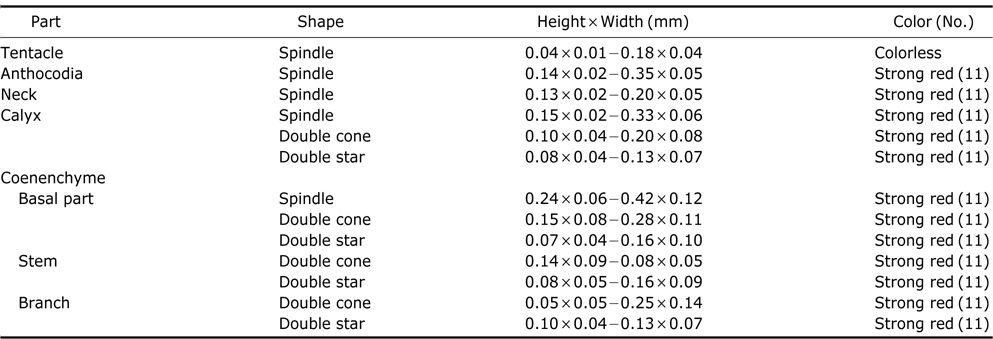
Measurements, shapes, and colors of spicules of Astrogorgia rubra
Material examined. Korea: 1 ind., Jeju-do: Seogwipo, 10 Jul 1969, Rho BJ; 1 ind., Seogwipo, 7 Aug 1970, Rho BJ; 1 ind., Seogwipo, 8 Aug 1970, Rho BJ; 1 ind., Seogwipo, 24 Dec 1971, Rho BJ; 1 ind., Seogwipo, 13 Apr 1975, Rho BJ, Song JI; 1 ind., Seogwipo, 14 Apr 1975, Rho BJ, Song JI; 1ind., Seogwipo, 20 Dec 1978, Rho BJ, Shin S, Yoon SJ, Song JI; 1 ind., Seogwipo, 30 Dec 1978, Rho BJ, Shin S, Yoon SJ, Song JI; 1 ind., Seogwipo-si, Munseom, 13 Jul 1985, Song JI; 1 ind., Seogwipo-si, Seopseom, 30 Dec 1987, Han HS; 1 ind., Seogwipo, 12 Dec 1988, Lee J, Seo J; 1 ind., Seongsanpo, 24 Oct 1994, Song JI, Won JH; 1 ind., Seogwipo-si, Munseom, 7 Apr 1997, Je JK; 1 ind., Seogwipo-si, Munseom, 21 Jan 1998, Song JI, Lee YJ; 1 ind., Seogwipo-si, Seopseom, 14 Jun 2006, Hwang SJ; 4 inds., Seogwipo-si, Munseom, 13 Feb 2006, Hwang SJ, Cho IY; 1 ind., Seogwipo-si, Munseom, 21 Apr 2006, Hwang SJ; 1 ind., Seogwipo-si, Munseom, 25 May 2006, INTHESEA KOREA; 4 inds., Seogwipo, 1 Aug 2005, Hwang SJ, Moon HY; 3 inds., Seogwipo-si, Munseom, 6 Sep 2006, Hwang SJ; 3 inds., Seogwipo-si, Munseom, 22 Jun 2007, Cho IY; 1 ind., Seogwipo-si, Munseom, 22 Jun 2007, Cho IY; 1 ind., Seogwipo-si, Seopseom, 23 Jun 2007, Cho IY; 4 inds., Seogwipo-si, Munseom, 15 Jul 2007, Cho IY; 8 inds., Seogwipo-si, Munseom, 14 Aug 2007, Hwang SJ, Cho IY; 3 inds., Seogwipo-si, Munseom, 27 Aug 2007, Hwang SJ, Cho IY; 1 ind., Seogwipo-si, Seopseom, 10 Sep 2007, Hwang SJ, Cho IY; 1 ind., Seogwipo-si, Seopseom, 10 Sep 2007, Hwang SJ, Cho IY; 3 inds., Seogwipo-si, Munseom, 10 Sep 2007, Hwang SJ, Cho IY; 3 inds., Seogwipo-si, Munseom, 10 Sep 2007, Hwang SJ, Cho IY; 5 inds., Seogwipo-si, Munseom, 11 Sep 2007, Cho IY; 6 inds., Seogwipo-si, Munseom, 11 Oct 2007, Cho IY; 5 inds., Seogwipo-si, Munseom, 10 Nov 2007, Hwang SJ; 6 inds., Seogwipo-si, Munseom, 10 Dec 2007, Hwang SJ; 3 inds., Seogwipo-si, Munseom, 28 Aug 2008, Hwang SJ; 8 inds., Seogwipo-si, Munseom, 28 Oct 2009, INTHESEA KOREA; 3 inds., Seogwipo-si, Munseom, 24 Nov 2009; 1 ind., Seogwipo-si, Munseom, 29 Aug 2010, Hwang SJ, Kim MS, Abygail R, Choi EA, 20-28 m deep by SCUBA diving and fishing nets.
Description. Colonies 65-420 mm in height and 17-400mm in width, planar growth form, anastomosis. Main branches 190-330 mm in length, 5-6 mm in width arise from stem at angles of 30-50° , 13-70 mm interval. Second branches 20-155 mm in length, 3-4 mm in width arise from main branches at angles of 30-80° , 15-40 mm interval. Third branches 40-70 mm in length, 3mm in width arise from second branches at angles of 30-45° , 10-30 mm interval. Dome shape calyxes mainly arranged at lateral side of main branch, alternately in all sides at branches. At lower part of main branches, calyxes attain 0.7-1.1 mm in height, 1.1-2.2 mm in width, 1.6-3.6 mm interval. At upper part of main branches, calyxes attain 0.6-1.1 mm in height, 1.6-2.1 mm in width, 1.3-2.7 mm interval. In thickness, coenenchyme 0.3-0.4 mm at stem, 0.2-0.3 mm at branch. Axis oval shape, 7-10 mm at stem and 0.5-0.6 mm at branch. In coloration, colony strong red (No. 11) with pale yellow red (No. 32) polyp. Axis dark green yellow (No. 104) at stem and pale yellow (No. 33) at branch.
Remarks. In comparison with Thomson and Henderson’s description (Thomson and Henderson, 1906), our specimens have a wide range of sizes of spicules in tentacle, 0.04×0.01 -0.18×0.04 mm. Also, they differ from spicules in anthocodia and neck.
Distribution. Pacific Ocean: Korea (Jeju-do Island), Japan (Kii Penin.).
Genus Euplexaura Verrill, 1869
Diagnosis. Colonies grow in one plane. Polyps retractile into calyxes. Calyxes quite large or completely absent. Coenenchyme contains oval or spheroidal spicules.
1*Euplexaura attenuata (Nutting, 1910) (Table 3, Fig. 4)
[Table 3.] Measurements, shapes, and colors of spicules of Euplexaura attenuata

Measurements, shapes, and colors of spicules of Euplexaura attenuata
Material examined. Korea: 1 ind., Incheon-si, Jakyakdo, 17 Sep 1974, Rho BJ, Song JI; 1 ind., Incheon-si, Jakyakdo, 4 Oct 1974, Rho BJ; 4 inds., Incheon-si, Jakyak-do, 25 Sep 1976, Ewha Womans University; 1 ind., Incheon-si, Jakyakdo, 17 Sep 1977, Ewha Womans University; 1 ind., Ulsan-si, Mipo, 28 Apr 1978, Park CY; 1 ind., Incheon-si, Jakyakdo, 2 Nov 1978, Park CY; 1 ind., Incheon-si, Jakyakdo, 28 Apr 1979, Shin S, Kim HK; 1 ind., Incheon-si, Jakyakdo, 27 Oct 1984, Song JI; 1 ind., Taean-gun, Anheung, 28 Oct 1984, Song JI; 1 ind., Incheon-si, Deokjeokdo, 15 Oct 1985, Song JI; 1 ind., Incheon-si, Jakyakdo, 4 Oct 1986, Ewha Womans University; 1 ind., Incheon-si, Deokjeokdo, 16 Oct 1985, Song JI; 1 ind., Incheon-si, Soyeonpeongdo, 12 Oct 1986, Lee JY; 1 ind., Incheon-si, Jakyakdo, 24 Oct 1987, Lee HS; 2 inds., Incheon-si, Jakyakdo, 26 Sep 1992, Ewha Womans University; 1 ind., Incheon-si, Jakyakdo, 7 Oct 1995, Ewha Womans University; 1 ind., Incheon-si, Jakyakdo, 17 Oct 1997, Song JI, Yoon SJ; 1 ind., Incheon-si, Jakyakdo, 28 Mar 1998, Ewha Womans University; 1 ind., Incheon-si, Jakyakdo, 28 Jul 1998, Ewha Womans University; 2 inds., Incheonsi, Jakyakdo, 9 Sep 2006, Song JI; 1 ind., Incheon-si, Shindo, 30 Jun 2007, INTHESEA KOREA; 1 ind., Incheon-si, Gwangdo, 30 June 2007, INTHESEA KOREA, intertidal zone to 3 m deep.
Description. Colonies 190-220 mm in height, 110-130mm in width, sparse and laterally branched growth form, no anastomosis. Stem straight, wand like. Main branches 35-220 mm in length, 2-3 mm in width arise from stem at angles of 40-90° , 7-50 mm interval. Lateral branches 50-110 mm in length, 2-3 mm in width arise from main stem at angles of 30-80° , 13-20 mm interval. Calyxes 0.3-0.5 mm in height, 0.9-1.6 mm in width distribute all over stems and branches at 0.7-2.3 mm interval. In thickness, coenenchyme 0.2-0.4 mm, axis 0.7-1.9 mm. In ethanol, colony very pale yellow (No. 43) with colorless polyp and dark yellow (No. 103) axis. At neck, specimens have delicate bands of spicules. Specimens retain gonad in July. Barnacles
Remarks. In comparison with the previous description (Stiasny, 1935), our specimens consist of small spicules in neck, 0.05×0.01−0.08×0.03 mm.
Distribution. Pacific Ocean: Korea (Yellow Sea, South Sea), Japan (Sagami Bay, Kii Penin.), China, Malay Archipelago, New Guinea, Timor Sea, West coast of Salawatti.
1*Euplexaura erecta Kükenthal, 1908 (Table 4, Fig. 5)
[Table 4.] Measurements, shapes, and colors of spicules of Euplexaura erecta

Measurements, shapes, and colors of spicules of Euplexaura erecta
Material examined. Korea: 3 inds., Ulsan-si, Mipo, 12 Oct 1978, Shin S; 1 ind., Seogwipo, 6 Jan 2009, INTHESEA KOREA; 6 inds., Jeju-si, Chujado, 20 Jun 2009, Song JI, 15- 27 m deep by SCUBA diving and fishing nets.
Description. Complete colonies 85-390 mm in height, 50-220 mm in width, pinnate growth form, no anastomosis. Main branches 35-145 mm in length, 2-5 mm in width arise from stem at angles of 20-90° , 8-23 mm interval. Second branches 20-170 mm in length, 2-3 mm in width arise from main branches at angles of 30-90° , 3-25 mm interval. Third branches 5-80 mm in length, 3 mm in width arise from second branches at angles of 30-90° . Stem and branches nearly flattened. Branches bend and run parallel to stem. Calyxes distribute all over stems and branches with 0.7-2.5 mm interval, nearly deficient in height. In thickness, coenenchyme 0.9-2.0 mm, axis 2.0-2.9 mm. In ethanol, colony light grayish yellow (No. 53) with colorless polyp, dark yellow red (No. 102) axis. Spicules of anthocodia consist of 3-4 rows of collaret, 3-4 pairs of points.
Remarks. In comparison with Kükenthal’s description (Kükenthal, 1908), our specimens have a wide range of angles in arising of the main branches, 20-90° . Also, they have a narrow interval in calyxes, 0.7-2.5 mm.
Distribution. Pacific Ocean: Korea (South Sea, Jeju-do Island), Japan (Enourabucht, Inan coast, Sagami Bay, Suruga Bay, Yamagata), China (Continental coast of Guangdong, Hong Kong).
